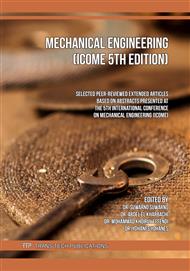[1]
A. Halim, B. Mahat, M. Hafiz, B. Saleh, M. Akashah, and B. Fauthan, Investigation and Failure Analysis for Camshaft,, Adv. J. Tech. Vocat. Educ., vol. 2, no. 2, p.23–27, (2018).
Google Scholar
[2]
A. Kurniawan and Andoko, Stress and Crack Simulation on Axle Housing Mitsubishi L300 Pickup Car using Finite Element Method,, IOP Conf. Ser. Mater. Sci. Eng., vol. 494, no. 1, p.1–7, (2019).
DOI: 10.1088/1757-899x/494/1/012107
Google Scholar
[3]
A. Andoko et al., Simulation of winglet with bend angles of 45, 60 and 90 degree,, in AIP Conference Proceedings, 2020, vol. 2262.
Google Scholar
[4]
L. Ping, L. Fengjun, C. Anke, and W. Bokang, Fracture analysis of chilled cast iron camshaft,, vol. 6, no. 2, p.104–108, (2009).
Google Scholar
[5]
A. S. Davale and V. R. Muttagi, ' Study of Modeling and Fracture Analysis of Camshaft ' A Review .,, vol. 2, no. 6, p.835–842, (2012).
Google Scholar
[6]
R. V Wanjari and T. C. Parshiwanikar, Failure of Camshaft,, no. 6, p.248–250, (2013).
Google Scholar
[7]
ASTM, Standard Specification for Automotive Gray Iron Castings,, vol. 03, no. Reapproved, p.1–5, (2000).
Google Scholar
[8]
H. Wang, C. Fu, W. Cui, X. Zhao, and S. Qie, Numerical simulation and experimental study on stress deformation of braided wire rope,, J. Strain Anal. Eng. Des., vol. 52, no. 2, p.69–76, Oct. (2016).
DOI: 10.1177/0309324716673232
Google Scholar
[9]
P. Andresen, B. Antolovich, S. Brecher, D. Broek, R. Bucci, and D. Cameron, Volume 19 Fatigue and Fracture. USA, (1996).
Google Scholar
[10]
Andoko and W. R. Amin, Investigation of Stress, Deformation, and Cracks in the Brakes of Car Using Finite Element Method,, IOP Conf. Ser. Mater. Sci. Eng., vol. 515, no. 1, (2019).
DOI: 10.1088/1757-899x/515/1/012090
Google Scholar
[11]
M. Zhao, C. Duan, X. Han, and X. Luo, Effects of Initial Crack Defect on Fatigue Crack Growth of Camshaft for Nuclear Emergency Diesel Engine,, IOP Conf. Ser. Mater. Sci. Eng., vol. 677, no. 3, (2019).
DOI: 10.1088/1757-899x/677/3/032059
Google Scholar
[12]
Andoko and N. E. Saputro, Failure simulation of connecting rods without pistons using finite element method,, MATEC Web Conf., vol. 204, p.07010, Sep. (2018).
DOI: 10.1051/matecconf/201820407010
Google Scholar
[13]
R. C. Juvinall and K. M. Marshek, Fundamentals of Machine Component Design, Fourth. United States: John Wiley & Sons, Inc., (2006).
Google Scholar
[14]
T. Rølvåg, B. Haugen, M. Bella, and F. Berto, Fatigue analysis of high performance race engines,, Eng. Fail. Anal., vol. 112, p.104514, (2020).
DOI: 10.1016/j.engfailanal.2020.104514
Google Scholar
[15]
T. A. Zucarelli, M. A. Vieira, L. A. Moreira Filho, D. A. P. Reis, and L. Reis, Failure analysis in railway wheels,, Procedia Struct. Integr., vol. 1, p.212–217, (2016).
DOI: 10.1016/j.prostr.2016.02.029
Google Scholar
[16]
K. Doshi, T. Roy, and Y. S. Parihar, Reliability based inspection planning using fracture mechanics based fatigue evaluations for ship structural details,, Mar. Struct., vol. 54, p.1–22, (2017).
DOI: 10.1016/j.marstruc.2017.03.003
Google Scholar



